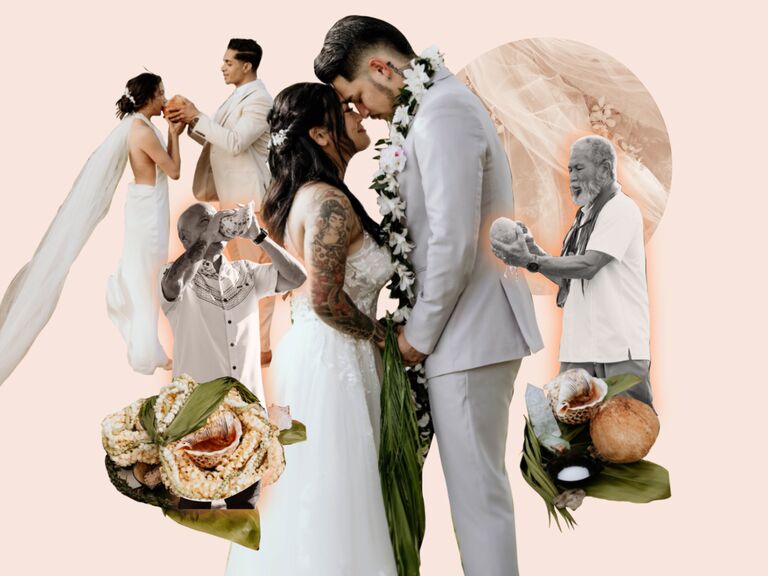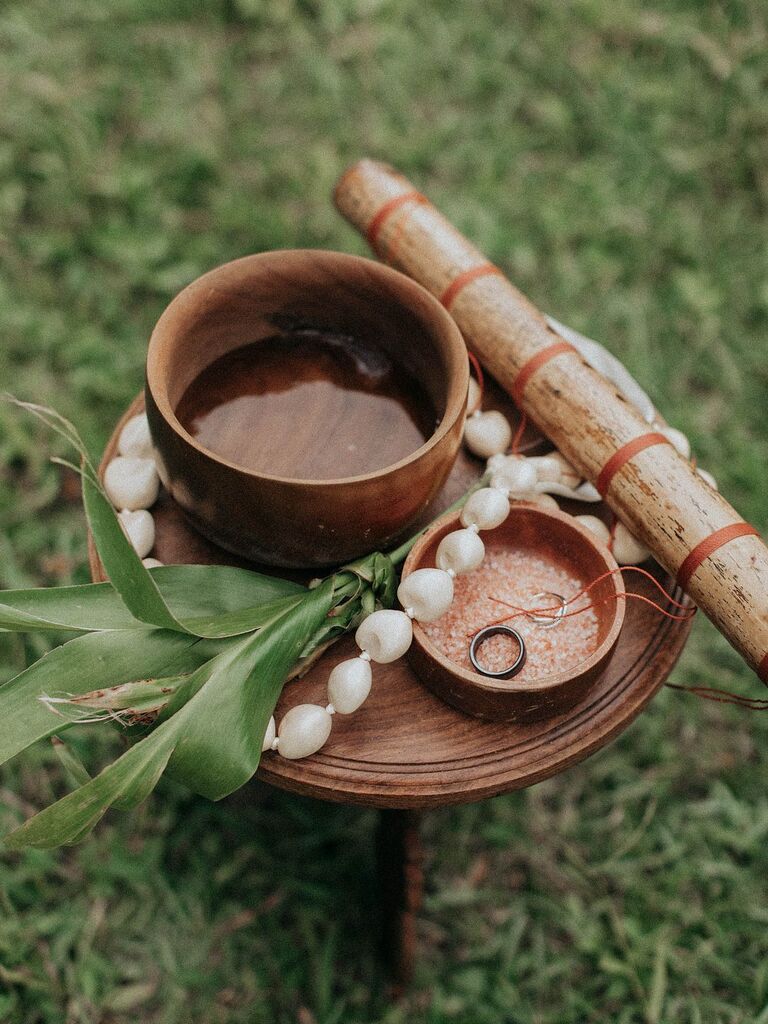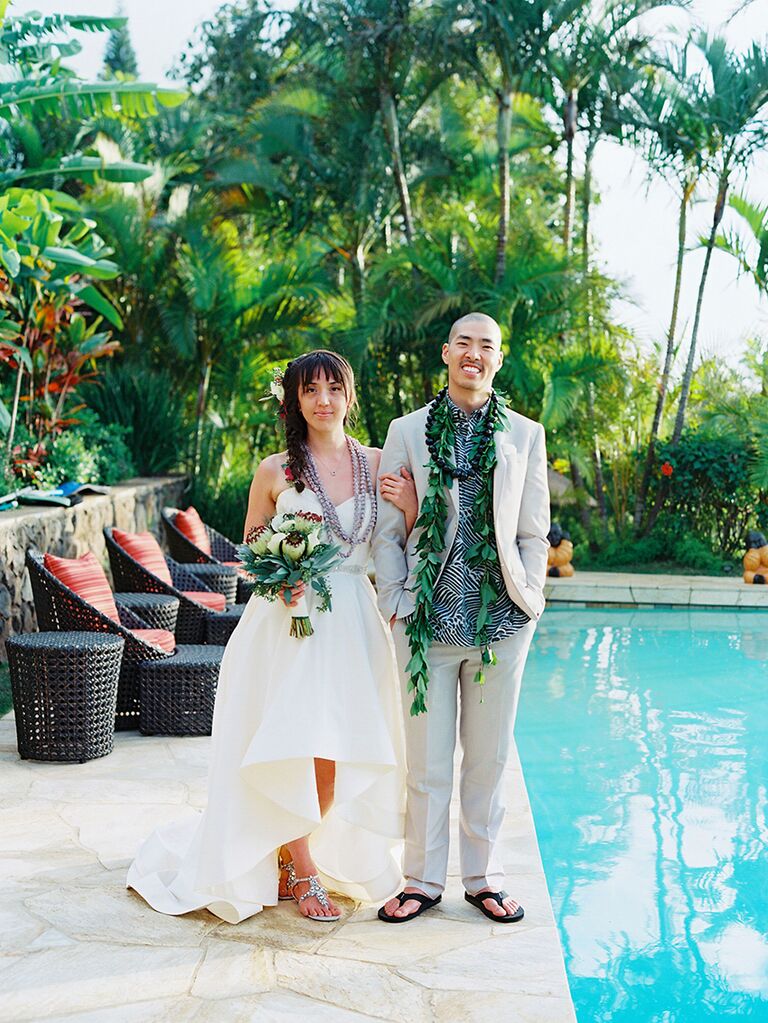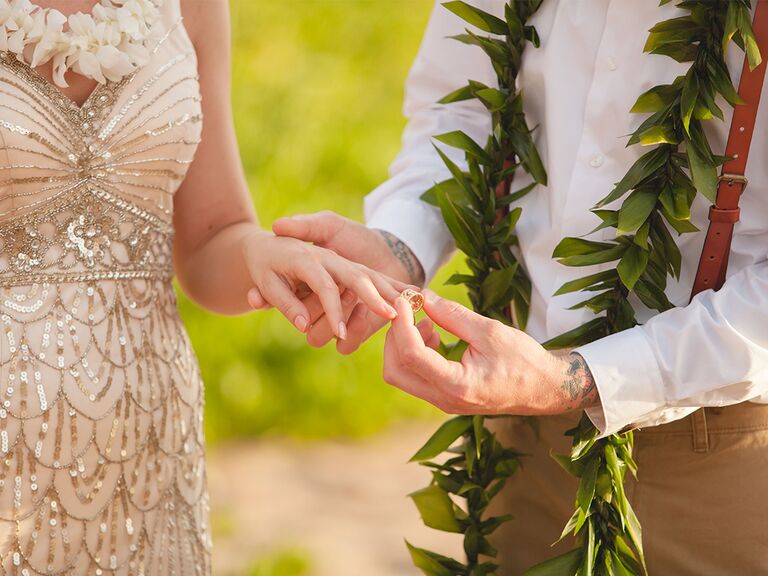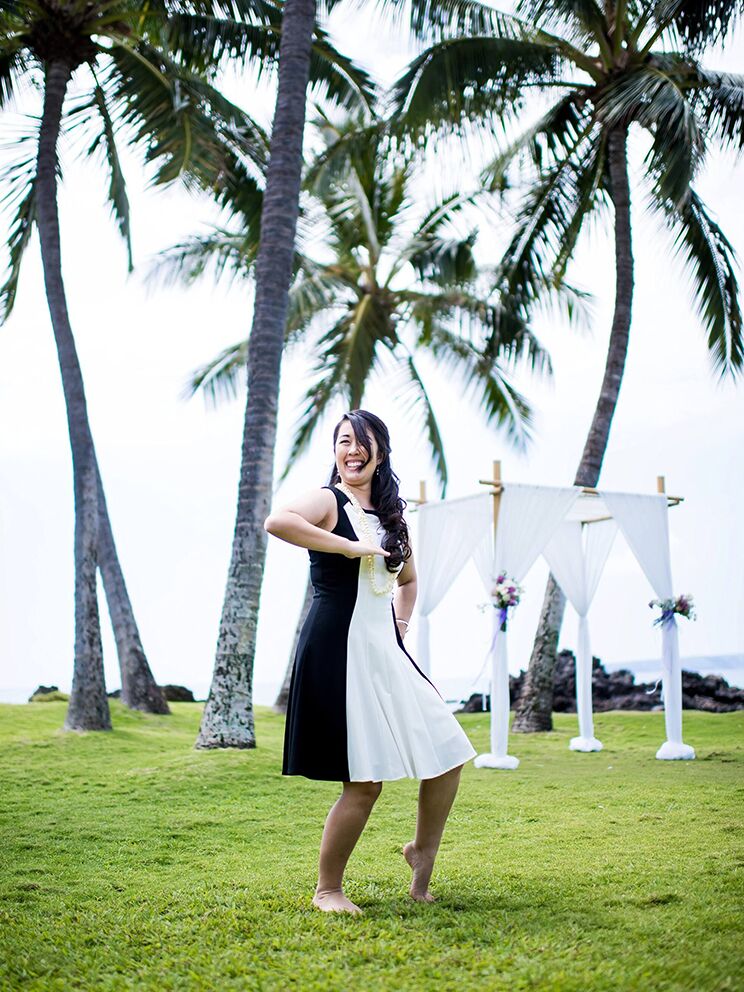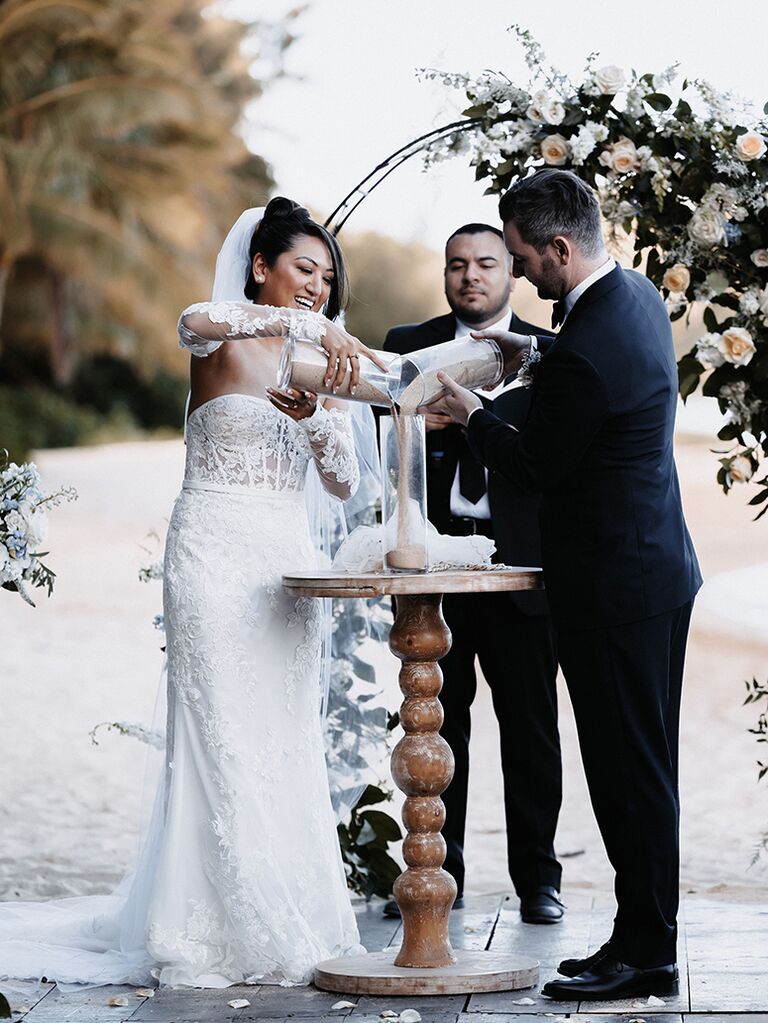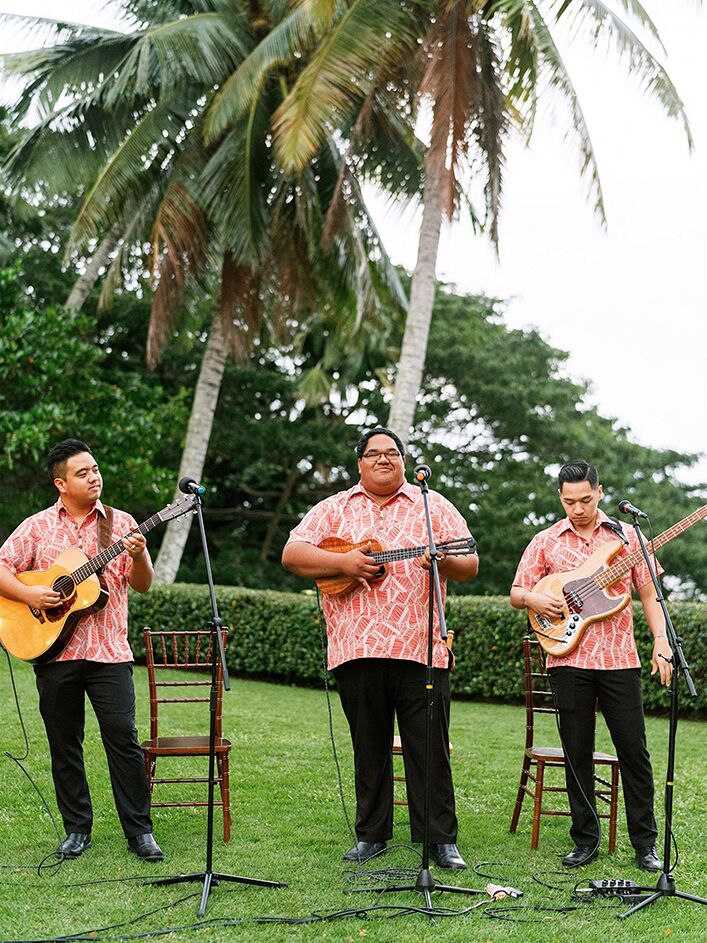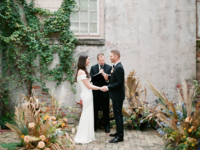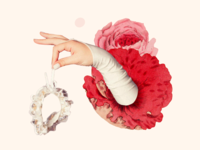23 Hawaiian Wedding Traditions That’ll Make the Big Day Special
If you're getting married on the Islands, you and your partner are undoubtedly enamored with the destination's beauty. But the location's culture is worth embracing too, which is why incorporating Hawaiian wedding traditions into your nuptials, whether or not it's part of your heritage, can open the eyes of your guests to the locale. To help guide you during this journey, we consulted with some of the best planning professionals and cultural experts about Hawaiian rituals and traditions. Read on to see what customs you can include in your nuptials to show your appreciation for the spirit of Aloha.
Hawaiian wedding traditions we love: History | Tradition | Attire | Ceremony | Tradition | Catering
A Brief History of Hawaiian Wedding Traditions
To understand traditional Hawaiian weddings, we contacted Kalei 'Uwēko'olani, a Cultural Programming Manager & Leadership Educator at Grand Wailea, A Waldorf Astoria Resort, to give us the 411. "In Hawaii, what's most important in any tradition is to continue to honor our families and the rituals of our ancestors. Today, many want to modify the tradition however, couples should not lose sight of the foundation of those traditions and to be sure they keep that spirit and ritual authentic. Today's couples must understand that Hawaiian weddings didn't really exist until the mid-1800s. Before that, traditions were varied based on the families."
If you're not Hawaiian but are having a wedding on one of the islands, Kelvin Ho, a respected wedding officiant since 1986, believes you should incorporate some Hawaiian wedding customs. "The truth is that the couple and their family's hearts are always going to be strongly connected to the sacred place. So it's important to use rituals from the land and the culture to ground, connect and align them to the ceremony with the love that everyone who has [used to help take care of] the land and ocean. That way, we align ourselves with their care and stewardship through our love and appreciation. So I think it's important to use ritual from the land and the culture and to have someone that's using it authentically," Ho explains.
Prewedding Hawaiian Tradition
Many different cultures have prewedding traditions. Here's one that Ho likes to do with his couples before the ceremony.
Handwashing Ritual
The handwashing custom acts as a "ritual bathing of the spirit, to release the past and embrace the love as a sacred path in the present." Ho continues, "So the hand washing is a ritual of purification through forgiveness, and it's understanding that forgiveness is what prepares and cleanses our hearts for a big passage and creates a space in our hearts for the union. Washing your own hands first says you have done the inner work and have come to a place of complete forgiveness and that you understand you're not pushing away the past but embracing it...Then you wash each other's hands to make the promise to hold the same forgiveness for one another throughout your love and your union."
Traditional Hawaiian Wedding Attire
Hawaiian wedding attire tends to be less rigid and can be casual if you'd like. Below are some clothing items you might see at a traditional Hawaiian wedding.
Holoku
A holoku is a long, formal gown created by Hawaiian women in the early 19th century after the arrival of Western missionaries. The garment, with its distinctive (sometimes ruffle-trimmed) train, was made to reflect Western fashion at the time. The dress is known for its loose-fitting design and intricate and vibrant Hawaiian-inspired patterns. The holoku is a beautiful staple in traditional Hawaiian fashion for kamaʻāina, which means "child of the land" or native-born Hawaiians.
Mu'umu'u
A mu'umu'u, which means to "cut off" or "shorten," is a casual loose dress that comes in many colors, fabrics and designs. Originally the mu'umu'u was worn under the holoku like a shift dress, but it eventually became a main garment donned for any occasion. Unfortunately, there was a time when mu'umu'u fell from grace (because it was considered unstylish) but natives are trying to bring the culturally significant dress back in fashion in different ways. One way they're doing so is by participating in Mu'umu'u Month.
Aloha Shirt
According to Teddy Brokaw of the Smithsonian Magazine, the aloha shirt's exact origin is still a mystery, but it's thought to have "first appeared in Hawaii in the 1920s or '30s probably when local Japanese women adapted kimono fabric for use in men's shirting." This casual shirt with island and tropical motifs is a perfect option for anyone wanting relaxed attire that reflects their beautiful Hawaiian destination and shows their appreciation for the land.
Hawaiian Wedding Ceremony Traditions
There are a lot of sentimental Hawaiian wedding rituals that occur during the ceremony. The 11 traditions below are some you can add to your wedding program.
The Oli Aloha
"Before written language existed in Hawaii, songs, chants and poems were used to record history. The wedding ceremony begins with the Oli Aloha, a chant that prepares the space for blessings and welcomes the couple and their guests," 'Uwēko'olani explains. "The words of the chant express longing and joy, saying, "This is the sight for which I have longed. Now that you have come, love has come with you," 'Uwēko'olani adds.
"In part, it says, 'There was a seeking of a loved one, now she is found. You two are now to become one," Sandra Wagner, nuptial expert and Principal Planner of A Maui Wedding Day, says. It ends with "Aloha" and "E komo mai," which means welcome.
Blowing of the Pū
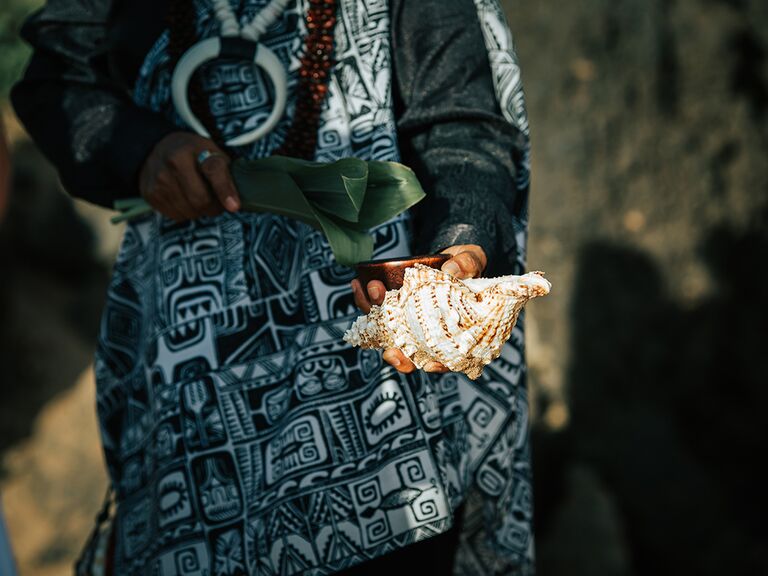
"The blowing of the conch shell horn, also known as the pū, is an ancient Hawaiian custom that was used in the past to announce the arrival of canoes, the entrance of ali'i (Hawaiian nobles), and to communicate between neighboring villages," Mina Singson-Brightman, wedding planner for more than a decade and CEO of Cherished in Hawaii, says. "It's an ancient Hawaiian fanfare meant to call attention to the significance of whatever is happening. Today, the pū is used to call for a gathering, to bless a home and to announce a marriage," Singson-Brightman adds.
Many ministers choose to blow the Pū during the ceremony entrances as a way to bring guests into a space of reflection. "[The blowing of the pū] calls out to the spirit world and to the people that a big event is unfolding. In a sense, it's like washing the space with breath and sound to get it ready to make a transition from everyday life into the time of ritual and ceremony," Ho explains. However, others blow it as the couple shares their first married kiss.
Hawaiian Ring Blessing
Before the Hawaiian ring wedding blessing starts, 'Uwēko'olani says the officiant blesses the rings with three elements: "koa wood, which symbolizes integrity and strength, the Ti leaf, which represents good health and prosperity and water, which signifies a fresh beginning as spouses." "The officiant sprinkles water over the rings while chanting, "'May peace from above rest upon you and remain with you now and forever,'" 'Uwēko'olani continues.
Lei Exchange
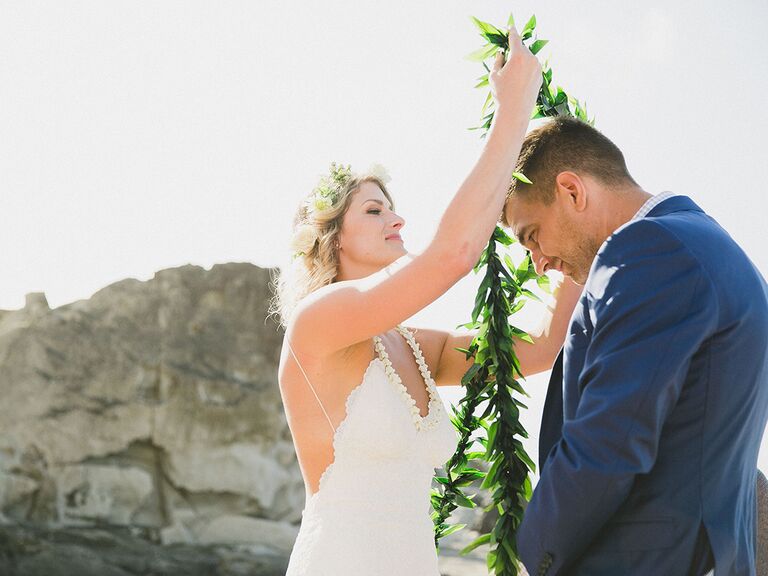
Hawaiian wedding leis, or flower garlands, are a love symbol, respect and the Aloha spirit. "In Hawaiian spirituality, giving and receiving a lei is believed to transfer energy and mana (spiritual power) between individuals. By exchanging leis, couples share their love and blessings, creating a spiritual bond that strengthens their relationship," 'Uwēko'olani says. The couple usually presents their leis to one another with a smile and kiss upon each other's cheek.



Grooms usually wear a garland of green maile leaves (sometimes with small white flowers, called pikake, woven in). Brides often wear several strands of pink and white pikake, which are entwined with orchids or rosebuds. The bride might also wear a headpiece of haku flowers and greenery. "In addition to exchanging leis with each other, couples may also present leis to their families, wedding party and guests as a gesture of gratitude and appreciation. This tradition reflects the importance of community and the interconnectedness of family and friends in Hawaiian culture," 'Uwēko'olani explains.
Hula
'Uwēko'olani breaks down what hula means in the Hawaiian culture. "Hula also serves as a way to honor our ancestors and preserve the cultural heritage of the Hawaiian people. By performing hula, couples pay homage to their roots, passing down this sacred tradition. Hula is not just a form of dance but also a form of storytelling. Each movement, gesture and expression conveys a specific meaning, allowing dancers to narrate myths, legends, and historical events through their performance."
When it comes to Hawaiian wedding traditions, hula can be a way to show the couple's love story or celebrate the big day. "Some brides may perform a special hula for their husbands during the wedding ceremony. This intimate and symbolic gesture serves as a declaration of love and commitment, with the bride expressing her devotion through the graceful movements of hula," 'Uwēko'olani tells us.
Hoʻāo
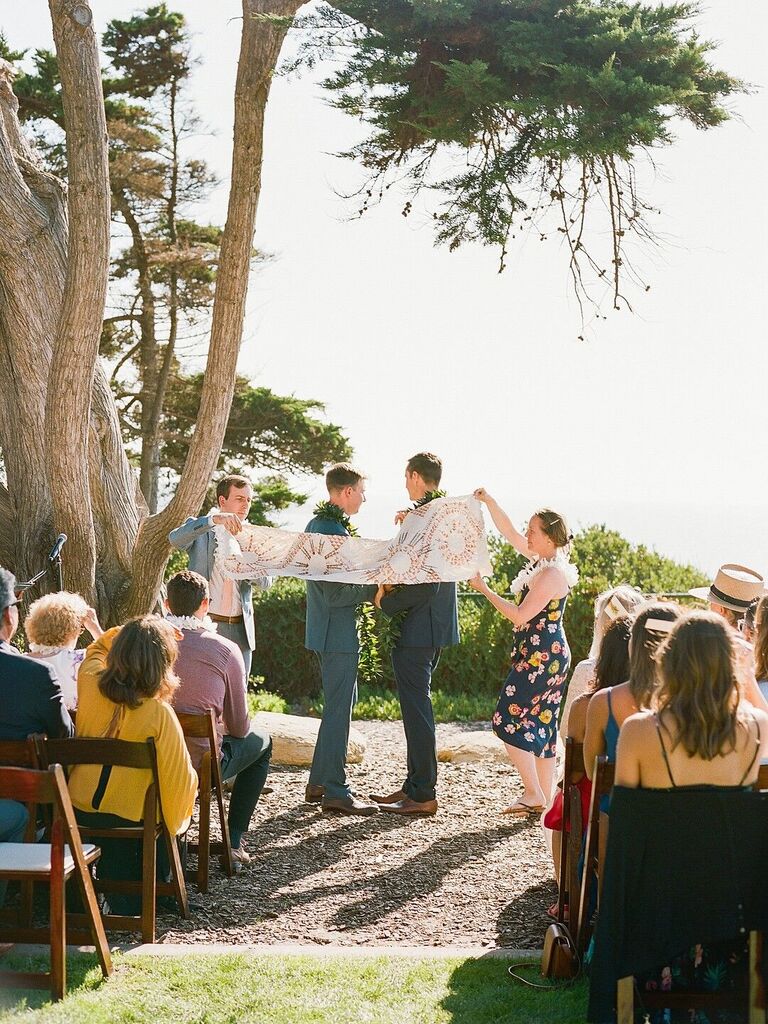
'Uwēko'olani's favorite Hawaiian wedding tradition is hoʻāo, which originates from the 1800ʻs. Hoʻāo, "translates to 'to make sacred' or 'to consecrate,' represents the spiritual and emotional bond between the couple." The couple is wrapped in kapa, white fabric, which symbolizes the couple's union and love for the following generations.
Pili ā Nai Kealoha
Pili ā nai kealoha translates to "love that binds." For this Hawaiian wedding tradition, the officiant ties the hands of the couple with a maile lei while chanting an accompanying oli. The maile lei is made with twisted green vines that are sometimes decorated with pikake or white orchids. The tradition represents the couple being intertwined in their love and urges the to-be-weds to have strong bonds––not only between themselves but with their loved ones.
The Sand Ceremony
Typically done at beach weddings, the sand ceremony is when the to-be-weds each get a small container of sand and pour it into a bag. This tradition represents the blending of the two people as a couple and their families.
The Lava Rock Ceremony
This ceremony involves a lava rock being wrapped in a Ti leaf, which is left at the wedding ceremony site. The Hawaiian wedding custom acts as a way to honor the couple's relationship and commitment while also being an offering to nature. (Psst. It's said that Maui has lots of beautiful black lava rocks.)
He Alo ā He Alo
This phrase translates to "face to face." "This oli marks the end of the ceremony and is a prayer for the couple to share Aloha in their marriage and honor the breath of life that's given to us," Brightman explains. Ho goes more in-depth into his favorite unique Hawaiian ritual. "Sharing of the breath or 'ha' is a really important one. You bring your foreheads to touch, you breathe into each other's breath and the blessing is said to seal the ceremony spiritually. A deeper meaning [to the tradition] is that you don't want the experience of where your love takes you in ceremony to just be a nice memory, [instead] you want to have access to that at any time in your journey together. So if the world gets rocky or you're in a blissful time, you can always access that place simply by bringing your foreheads together and breathing into each other's breath," Ho says.
Why Time and Location Is Important
"In Hawaiian culture, the timing of a wedding holds deep significance, reflecting both ancient traditions and the spirit of Aloha. The timing of a Hawaiian wedding is not merely practical—it's a bridge connecting ancient customs, blessings, and the celebration of love," 'Uwēko'olani says. Whether you're in Oahu or Kauai, picking a location that connects the couple is crucial because it allows everyone to bond with the land more authentically. "The choice of location pays tribute to the rich cultural heritage influenced by Asian, Western, and Polynesian traditions. Whether it's a beach, lush garden, or volcanic landscape, the setting becomes part of their love story. Hawaii's natural beauty—majestic volcanoes, golden sand beaches and stunning sunsets—adds a spiritual dimension to the wedding. [Therefore,] the land itself becomes a witness to the union," 'Uwēko'olani adds.
Hawaiian Wedding Reception Tradition
At Hawaii wedding receptions, there are two things you'll most likely see included. Consider doing these before finalizing your reception schedule.
"Ke Kali Nei Au"
This song is a common choice on Hawaiian wedding playlists. "Ke Kali Nei Au," which translates to "Waiting for Thee," is also known as "The Hawaiian Wedding Song." The song has been covered by big artists like Bing Crosby and Elvis Presley and is a beautiful tune about someone pledging their love to their sweetheart.
Ahaana
"What would a wedding be without celebrating with an Ahaana (feast or dinner party) of foods chosen to represent a specific purpose? Food is an area where couples can lean into the items and recipes of their ancestors that are important to the two families joining as one. At a Hawaiian wedding, the food isn't just about nourishment—it's a feast of symbolism, tradition and the spirit of Aloha," 'Uwēko'olani says. We'll go into more detail about those Hawaii wedding food items below.
Traditional Hawaiian Wedding Food and Desserts
Food is an excellent (not to mention delicious) way to incorporate Hawaiian culture and tradition into your wedding day. Here are some Hawaiian wedding food traditions you might see on the big day.
Poi
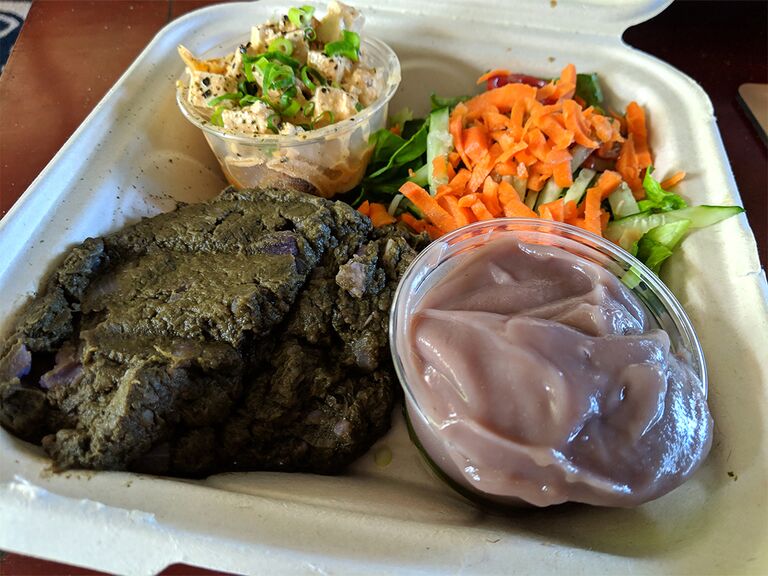
Poi, a purple paste made from pounded taro root, is a delicious local dish with Polynesian origins. This sweet (sometimes tangy) fare pairs well with fish and Kalau pig but can also be eaten on its own.
Laulau

If you're serving meat, consider laulau, a comfort food preparation method in Hawaii. Traditionally, fatty pork and butterfish pieces are wrapped in taro (lu'au) and Ti leaves and steamed. The flavorful meal can include corned beef, chicken thighs or turkey tails and is served with sweet potatoes, poi and much more.
Poke
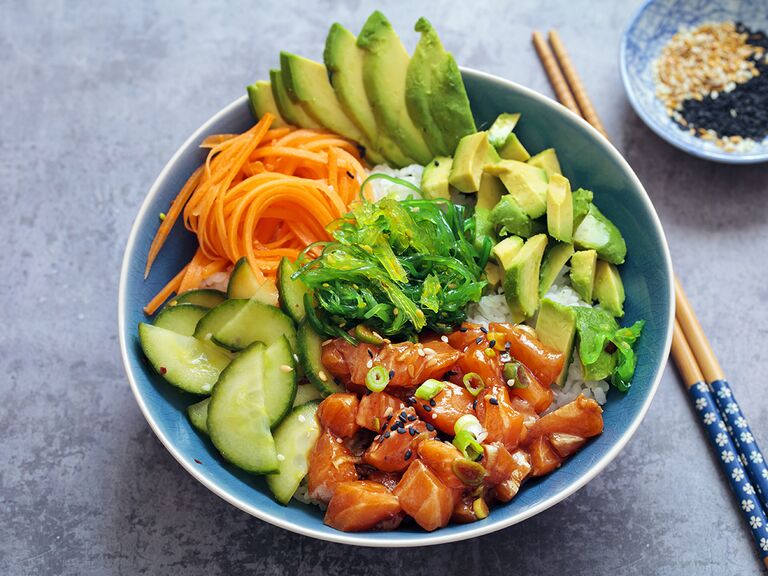
Poke is an appetizer or main dish that's composed of diced marinated raw fish served with vegetables and seaweed on top of rice. There are lots of modern and cultural takes on the Hawaiian dish, like some made using octopus, chicken or tofu and garnished with wasabi or kimchi. Feel free to get creative with your poke toppings and have a poke station at your wedding.
Ahi
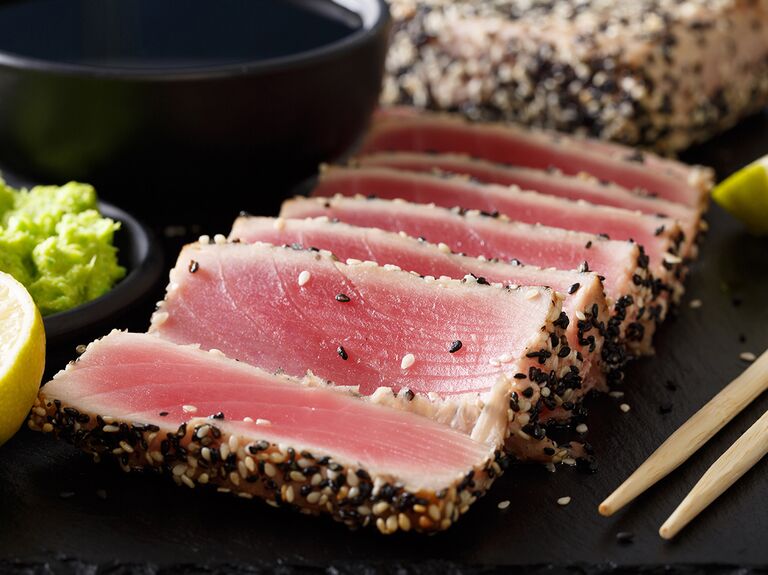
Considering the proximity to the ocean, it's not surprising the fresh fish and excellent produce of the islands take center stage, graced by a multi-ethnic mélange of flavors. Asian and Indo-Pacific influences like Thai, Japanese and Polynesian have made Hawaiian cuisine a fascinating adventure. Ahi, or tuna, is seared and crusted in sesame, while other seafood is cooked in a Hawaiian bouillabaisse (fresh fruit sauces made from guava, papaya, pineapple and lychee).
Kalua Pig
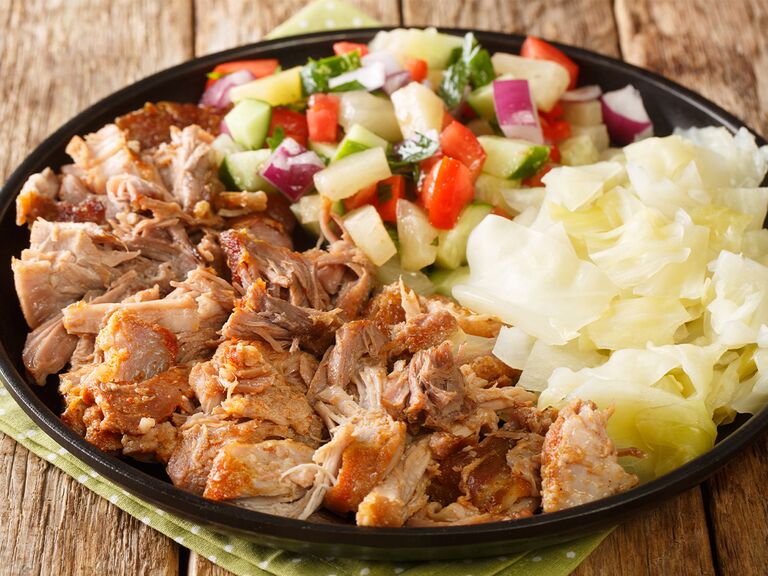
If you're having an outdoor wedding, you should consider having a luau, which means you can't skip out on serving a kalua pig. Kalua means "[from the] pit," which refers to the staple's cooking process in an imu, underground oven. The opening of the imu is sometimes viewed as the start of the after-ceremony festivities.
Kūlolo
Kūlolo is coconut pudding with brown sugar and taro flavoring that's served as a small square. This dessert's consistency is said to be a mix between fudge and mochi. Show off your knowledge of Hawaiian culture by having kūlolo at your wedding dessert table.
